The Predators Prowl is a weekly post on how the Nashville Predators performed the previous week. Generally published on Tuesdays, Predators Prowl isn’t a recap of games, but rather a look at the themes, news and rumors that occurred throughout the week. Let me know in the comments below your thoughts on how the team performed this week, your views on the week’s themes and any other ideas or questions you have about the team.
Related: Last Week’s Predators Prowl
This week, the Predators’ bye week concluded and they returned to the ice with two games, a road matchup against the Florida Panthers on Friday and a home game the next night against the Dallas Stars. They entered the Panthers game four points back of the Winnipeg Jets for the Central Division and needed complete efforts in both games. They put forth that effort in one game, but not the other.
A Tale of Two Teams
The Predators split the back-to-back games, with a 4-1 win over the Panthers and a 3-1 loss to the Stars. What’s interesting is that in some ways the on-ice products looked different than the final scores, but in other ways, the results were accurate.
Saros Nearly Unbeatable Against Panthers
For the most part, the Predators turned in a total team effort against the Panthers. Although they were outshot 28-26 in all situations, they controlled five-on-five metrics. This includes controlling scoring chances 25-12 and high-danger chances 10-3, which results in a season-high 76.9 percent.
Goaltender Juuse Saros stopped 27 of 28 shots for a .964 save percentage (SV%) and he turned aside all five medium-danger shots and seven of seven high-danger shots. The lone goal he allowed occurred on the power play due to a perfectly-placed shot by Jonathan Huberdeau.
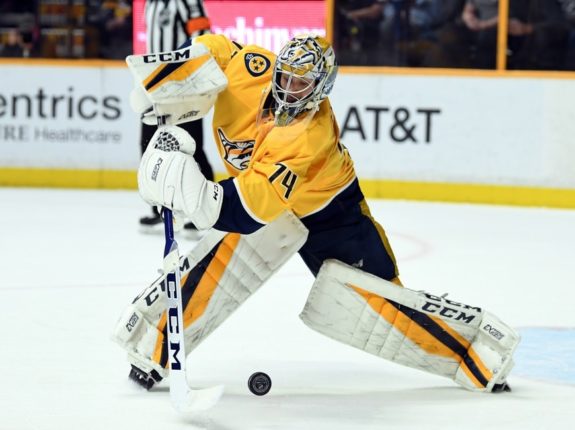
Offensively, the Predators may have scored four goals, but one was an empty-netter, and they benefited from some questionable goaltending by Roberto Luongo. On the Predators’ first goal, scored by Roman Josi, Ryan Johansen stripped Florida’s Colton Sceviour of the puck as he attempted to exit the zone and passed it to Filip Forsberg. Forsberg found Josi streaking into the offensive zone and he snapped it past Luongo. While it was a well-placed shot, Luongo had time to get his angle against Josi and there was no traffic in front. He was simply beat glove side.
On the second goal, the Predators gained zone entry off a neutral-zone faceoff. Viktor Arvidsson’s tip into the offensive zone was broken up by Panthers defenseman Keith Yandle but the puck went onto Forsberg’s stick. He drop-passed it to Arvidsson, who took the pass, and while in stride, attempted a slap shot that beat Luongo. It was a clean shooting lane with no traffic in front, and the Panthers succeeded in boxing out their assignments. While there is a chance the shot was deflected by Frank Vatrano, the shot beat Luongo on his blocker side as he was slow to react.
Kevin Fiala scored Nashville’s third goal on a beautiful individual effort. However, despite his efforts, Luongo should have at least cut down the angle. Fiala out-muscled Florida defenseman Mark Pysyk, and while Luongo attempted to poke check the puck, Fiala regained possession and roofed it blocker side. While it was an accurate shot, Luongo left a lot of net open for said shot to find twine. All-in-all, though, the Predators and their coaching staff had to be happy with the effort and the results.
Rinne Struggles Against Stars
The next night, the Predators were back in the friendly confines of Bridgestone Arena in Nashville. However, the confines weren’t so friendly that night as the Predators dropped the game. That result was in spite of the team controlling play, including a 39-26 shot advantage in all situations. Yet a look at the five-on-five metrics reveals a lesser control of play with a 14-12 advantage in control of scoring chances and an 8-5 advantage in high-danger chances.
Not many Predators had a great game against the Stars, including Pekka Rinne, who stopped 23 of 26 shots for an .885 SV%. Two of the goals he allowed occurred on high-danger chances, but he didn’t help himself as he had the chance to stop all three goals. On the first goal, he failed to stop, or at least slow, down Dallas’ dump-in, which allowed the puck to carom around the boards and end up on Tyler Seguin’s stick. Seguin, an elite goal scorer, wasted no time and roped a shot past Rinne that could have been stopped as there was no traffic in his sight line.
On the second goal, Ryan Ellis lost position on Radek Faksa and was ultimately out-muscled by Faksa for puck control. Faksa passed it to an open Blake Comeau, who probably should have been covered by Colton Sissons, but wasn’t. Comeau skated the puck around the goal mouth, providing Rinne chances to poke check the puck but he failed to and Comeau waited out Rinne for the open net.
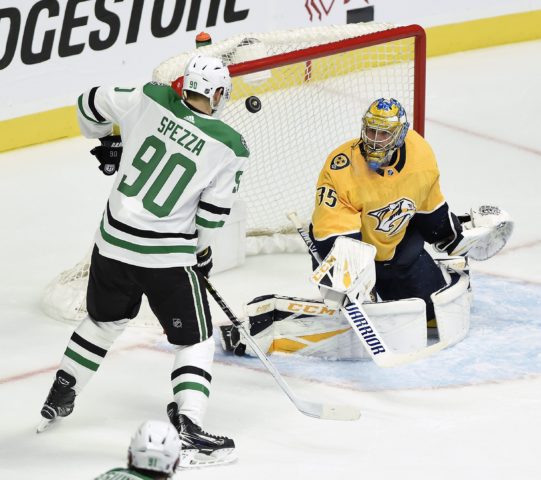
On the last goal, Rinne gave up a terrible rebound after he let an easy shot bounce out of his glove. Two Stars were driving the net, Faksa and Mattias Janmark. P.K. Subban did a good job to tie-up Faksa and prevent him from getting a scoring chance while Ellis failed to tie-up Janmark, the goal scorer. If the Panthers game was one the team and coaching staff gladly accepted, the Stars game was one they couldn’t have been pleased with. The Predators need more consistent efforts from everyone to be competitive down the stretch and into the postseason.
Changes to the Power Play
Finally! After a season of mediocrity on the power play and listening to what felt like months of calling for change on the units, including from myself, the Predators coaching staff made changes. In a league that has gone to the four forwards, one defenseman model, at least on the top unit, the Predators went with three forwards and two defensemen on both units. Well, starting with the Panthers game, change came.
It used to be that the top unit was comprised of Arvidsson, Forsberg, Johansen, Ellis and Josi, or their top line and top defense pair. Meanwhile, their second unit was a mixed bag of forwards, usually consisting of at least Fiala and Craig Smith, and with Mattias Ekholm and Subban on the blue line. The new top unit, however, has a lot more firepower, at least on paper, or screen.
Arvidsson, Forsberg, Johansen and Josi remain from the original top unit, but now Smith has been bumped up. This gives them four talented forwards, with Forsberg at the point, and a defenseman that often operates like a forward. The second unit now consists of Nick Bonino, Fiala and Sissons up front with Ekholm and Subban on the back end.
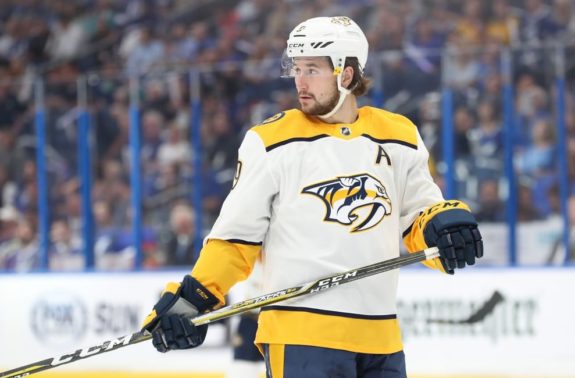
How Have the Early Returns Been?
In the Panthers game when they debuted the new units, the power play clicked even though they went 0-for-2. The first unit played 2:21 together while the second unit received 25 seconds. They generated a ton of chances in that time with 65.1 shots for per-60 minutes (SF/60), their highest since Dec. 29, and 43.4 scoring chances for per-60 (SCF/60), their highest since Jan. 15, yet they had no high-danger chances. But despite the lack of high-danger chances, they attempted more shots from the slot than normal, and that’s a good thing.
The next night against the Stars, the power play came back to earth a bit, although they did have four opportunities, which reduces the per-60 stats. In that game, each member of the top unit played at least four minutes on the man advantage while those on the second unit played between 1:46 and 2:01. The power play as a whole still attempted 49.2 SF/60 and 9.84 SCF/60, with an equal number of high-danger chances per-60.
The Predators may not have scored on the power play in either game, but they got plenty of opportunities and put a lot of shots on net. If head coach Peter Laviolette continues to go with these setups, it’s only a matter of time before they convert and the power play gets rolling.
Reverting Back to Typical Defense Pairs
If altering the power play after the bye week wasn’t enough, Laviolette and his coaching staff also changed the team’s defense pairs back to the original pairs. For a portion of January, the top-four had been changed so that Josi and Subban were a pair as were Ekholm and Ellis. However, as I mentioned in last week’s Predators Prowl, the new pairs had questionable results. The Ekholm/Ellis pair worked well, but the Josi/Subban one struggled, so it wasn’t a surprise the team went back to the original pairs.
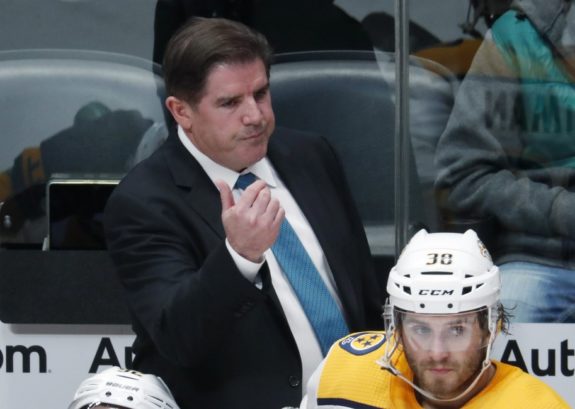
Versus Florida
Against the Panthers, this resulted in Josi playing nearly 19 minutes, Ekholm and Ellis playing 16:27 each and Subban playing 15:40, all even strength minutes. The Ellis/Josi pair mostly played against the Aleksander Barkov, Evgeni Dadonov and Vatrano line and dominated them as the Predators controlled 75 percent of shots when the two sides were deployed against each other.
Meanwhile, the Ekholm/Subban pair generally went against Florida’s Huberdeau, Vincent Trocheck and Denis Malgin line. The teams had a 50-50 shot share split when the Predators pair faced the Panthers line.
Versus Dallas
The next night, against the Stars, Josi again led the way in ice time with 20:58, however Ekholm, Ellis and Subban all skated more than 20 minutes, too. Ellis and Josi received a lot of offensive zone starts and went against Dallas’ Janmark, Seguin and Alexander Radulov line a majority of the time. However, in this game, the pair got caved in by the line as the Stars controlled 75 percent of shots when the line and pair faced off. Ellis and Josi were also on the ice for two of Dallas’ goals.
Conversely, the Ekholm/Subban pair had the opposite effect as the Predators controlled 75 percent of shots when the pair faced the Comeau, Faksa and Jamie Benn line. Subban was on the ice for one Stars’ goal, but the pair was on the ice for a lot of defensive zone draws. I feel that these pairs should remain intact and allow them to regain the chemistry they developed over a season of playing together. It’s the best way to capitalize on the team’s defensive talent.
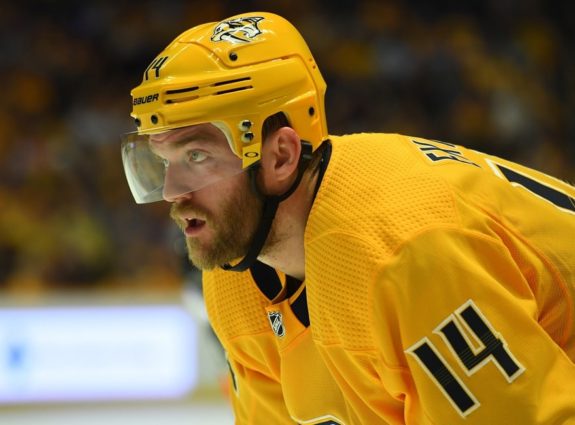
News, Top Performers and the Week Ahead
In a sensitive subject, Austin Watson was suspended indefinitely on Jan. 30 by the NHL as he enters stage two of the league and player association’s Substance Abuse and Behavior Health Program due to alcohol abuse. This comes on the heels of his earlier suspension for domestic violence.
Top Performers
- Filip Forsberg – 3 assists
- Roman Josi – 1 goal, 1 assist
- Viktor Arvidsson – 2 goals
- Juuse Saros – 1 start, 1-0-0 record, stopped 27 of 28 shots, .964 SV%
The Week Ahead
- Feb. 5 vs. Arizona Coyotes
- Feb. 7 vs. Stars
- Feb. 9 at St. Louis Blues
- Feb. 10 vs. Blues
*All stats came from Hockey-Reference, Natural Stat Trick, Corsica Hockey and HockeyViz